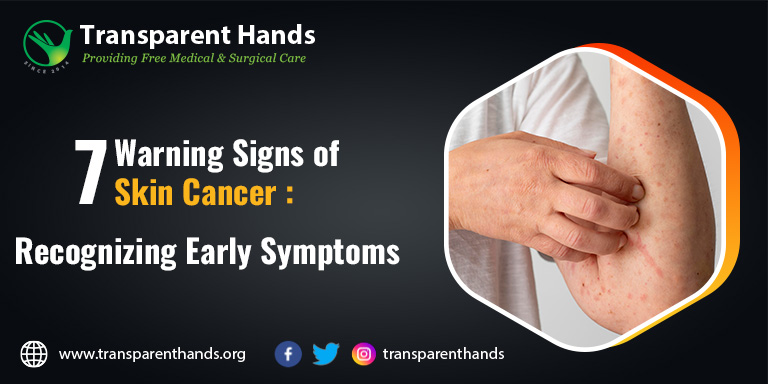7 Warning Signs of Skin Cancer: Recognizing Early Symptoms

Skin cancer is the most common form of cancer, affecting millions of people worldwide. Recognizing the early signs of skin cancer is crucial for prompt diagnosis and effective treatment. In this article, we will discuss the seven warning signs of skin cancer that should not be ignored. By being aware of these signs and taking appropriate action, individuals can increase their chances of successful treatment and recovery. Let’s dive into the key indicators of skin cancer to empower ourselves with knowledge and promote skin health.
Without further ado, let’s discuss the signs to give some information about the issue.
1.Unusual Moles or Lesions
One of the first warning signs of skin cancer is the appearance of unusual moles or lesions on the skin. These may manifest as irregularly shaped or colored growths. Pay attention to moles that exhibit the ABCDE characteristics:
- Asymmetry: One half of the mole doesn’t match the other half.
- Border: Irregular or poorly defined edges.
- Color: Uneven coloration or multiple shades within the same mole.
- Diameter: Moles larger than 6 millimeters (about the size of a pencil eraser).
- Evolution: Moles that change in size, shape, or color over time.
If you notice any of these characteristics in a mole or lesion, consult a dermatologist for further evaluation.
2.Changes in Existing Moles
Existing moles can also serve as indicators of skin cancer. Monitor your moles regularly for any changes, as this can be a sign of malignancy. Look for alterations in color, shape, size, or texture. Any mole that begins to itch, bleed, or develop crusts should be examined by a medical professional. Moreover, the emergence of a bump or nodule within a mole can indicate a potential problem. Remember, early detection is key, and seeking medical advice at the first sign of change can make a significant difference in successful treatment outcomes.
3.Sores That Don’t Heal
Skin cancer can present as non-healing sores or ulcers that persist for several weeks. These sores may bleed, ooze, or crust over but do not seem to heal despite appropriate care. If you have a sore that does not respond to standard treatments or shows signs of deterioration, it is crucial to consult a dermatologist promptly. Such persistent sores could be indicative of basal cell carcinoma, squamous cell carcinoma, or even melanoma, the most aggressive form of skin cancer.
4.Red or Inflamed Patches
Skin areas that appear persistently red, inflamed, or irritated without any known cause should raise concerns because that is among the crucial warning signs of skin cancer. These patches may feel tender or painful to the touch. While redness can be a symptom of various skin conditions, including eczema or dermatitis, it is essential to rule out the possibility of skin cancer. Consult a dermatologist to evaluate the underlying cause and determine the appropriate course of action.
5.Sudden Changes in Skin Sensation
One of the warning signs of skin cancer is the unexplained changes in skin sensation, such as itching, tenderness, or pain, and they should be taken seriously. These sensations may be localized to a specific area or affect a broader region. Skin cancer cells can disrupt normal nerve pathways, leading to abnormal sensations. Any persistent or unexplained discomfort warrants a thorough examination by a healthcare professional to identify the cause and provide appropriate treatment.
6.Spots or Patches with Irregular Borders
Skin cancer lesions often exhibit irregular or jagged borders. These spots may lack a defined edge, making them distinct from benign skin conditions. Pay attention to areas of the skin that have unusual shapes or blurred boundaries. While not all irregular-shaped spots indicate skin cancer, any spot with such characteristics should be evaluated by a dermatologist to rule out malignancy.
7.New Growth or Pigmentation
The sudden appearance of new growths or pigmented areas on the skin can be a warning sign of skin cancer. These growths may be brown, black, or multicolored and can emerge anywhere on the body. Keep an eye out for any new spots, bumps, or patches that arise, and do not fade or disappear over time. A timely medical examination is crucial to determine if these changes are benign or require further investigation.
How effective is Stem Cell Therapy?
Conclusion
Recognizing the early warning signs of skin cancer is vital for timely intervention and better treatment outcomes. By understanding the warning signs mentioned above and being vigilant about changes in our skin, we can take proactive steps to protect ourselves. Remember, it is crucial to consult a dermatologist if any of these signs appear or if you have concerns about your skin. Regular self-examination, sun protection measures, and seeking professional medical advice when needed are essential in maintaining skin health and reducing the impact of skin cancer on our lives.










Leave a Reply